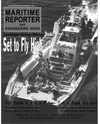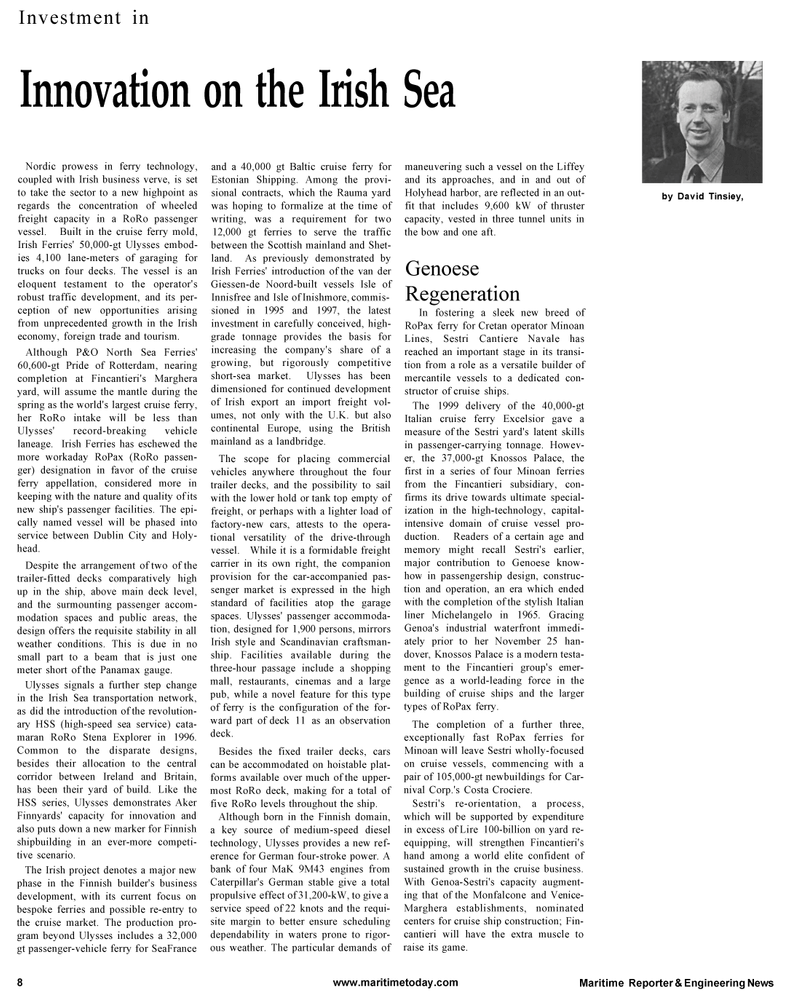
Page 8: of Maritime Reporter Magazine (January 2001)
Read this page in Pdf, Flash or Html5 edition of January 2001 Maritime Reporter Magazine
Investment in
Innovation on the Irish Sea
Nordic prowess in ferry technology, coupled with Irish business verve, is set to take the sector to a new highpoint as regards the concentration of wheeled freight capacity in a RoRo passenger vessel. Built in the cruise ferry mold,
Irish Ferries' 50,000-gt Ulysses embod- ies 4,100 lane-meters of garaging for trucks on four decks. The vessel is an eloquent testament to the operator's robust traffic development, and its per- ception of new opportunities arising from unprecedented growth in the Irish economy, foreign trade and tourism.
Although P&O North Sea Ferries' 60,600-gt Pride of Rotterdam, nearing completion at Fincantieri's Marghera yard, will assume the mantle during the spring as the world's largest cruise ferry, her RoRo intake will be less than
Ulysses' record-breaking vehicle laneage. Irish Ferries has eschewed the more workaday RoPax (RoRo passen- ger) designation in favor of the cruise ferry appellation, considered more in keeping with the nature and quality of its new ship's passenger facilities. The epi- cally named vessel will be phased into service between Dublin City and Holy- head.
Despite the arrangement of two of the trailer-fitted decks comparatively high up in the ship, above main deck level, and the surmounting passenger accom- modation spaces and public areas, the design offers the requisite stability in all weather conditions. This is due in no small part to a beam that is just one meter short of the Panamax gauge.
Ulysses signals a further step change in the Irish Sea transportation network, as did the introduction of the revolution- ary HSS (high-speed sea service) cata- maran RoRo Stena Explorer in 1996.
Common to the disparate designs, besides their allocation to the central corridor between Ireland and Britain, has been their yard of build. Like the
HSS series, Ulysses demonstrates Aker
Finnyards' capacity for innovation and also puts down a new marker for Finnish shipbuilding in an ever-more competi- tive scenario.
The Irish project denotes a major new phase in the Finnish builder's business development, with its current focus on bespoke ferries and possible re-entry to the cruise market. The production pro- gram beyond Ulysses includes a 32,000 gt passenger-vehicle ferry for SeaFrance and a 40,000 gt Baltic cruise ferry for
Estonian Shipping. Among the provi- sional contracts, which the Rauma yard was hoping to formalize at the time of writing, was a requirement for two 12,000 gt ferries to serve the traffic between the Scottish mainland and Shet- land. As previously demonstrated by
Irish Ferries' introduction of the van der
Giessen-de Noord-built vessels Isle of
Innisfree and Isle of Inishmore, commis- sioned in 1995 and 1997, the latest investment in carefully conceived, high- grade tonnage provides the basis for increasing the company's share of a growing, but rigorously competitive short-sea market. Ulysses has been dimensioned for continued development of Irish export an import freight vol- umes, not only with the U.K. but also continental Europe, using the British mainland as a landbridge.
The scope for placing commercial vehicles anywhere throughout the four trailer decks, and the possibility to sail with the lower hold or tank top empty of freight, or perhaps with a lighter load of factory-new cars, attests to the opera- tional versatility of the drive-through vessel. While it is a formidable freight carrier in its own right, the companion provision for the car-accompanied pas- senger market is expressed in the high standard of facilities atop the garage spaces. Ulysses' passenger accommoda- tion, designed for 1,900 persons, mirrors
Irish style and Scandinavian craftsman- ship. Facilities available during the three-hour passage include a shopping mall, restaurants, cinemas and a large pub, while a novel feature for this type of ferry is the configuration of the for- ward part of deck 11 as an observation deck.
Besides the fixed trailer decks, cars can be accommodated on hoistable plat- forms available over much of the upper- most RoRo deck, making for a total of five RoRo levels throughout the ship.
Although born in the Finnish domain, a key source of medium-speed diesel technology, Ulysses provides a new ref- erence for German four-stroke power. A bank of four MaK 9M43 engines from
Caterpillar's German stable give a total propulsive effect of 31,200-kW, to give a service speed of 22 knots and the requi- site margin to better ensure scheduling dependability in waters prone to rigor- ous weather. The particular demands of maneuvering such a vessel on the Liffey and its approaches, and in and out of
Holyhead harbor, are reflected in an out- fit that includes 9,600 kW of thruster capacity, vested in three tunnel units in the bow and one aft.
Genoese
Regeneration
In fostering a sleek new breed of
RoPax ferry for Cretan operator Minoan
Lines, Sestri Cantiere Navale has reached an important stage in its transi- tion from a role as a versatile builder of mercantile vessels to a dedicated con- structor of cruise ships.
The 1999 delivery of the 40,000-gt
Italian cruise ferry Excelsior gave a measure of the Sestri yard's latent skills in passenger-carrying tonnage. Howev- er, the 37,000-gt Knossos Palace, the first in a series of four Minoan ferries from the Fincantieri subsidiary, con- firms its drive towards ultimate special- ization in the high-technology, capital- intensive domain of cruise vessel pro- duction. Readers of a certain age and memory might recall Sestri's earlier, major contribution to Genoese know- how in passengership design, construc- tion and operation, an era which ended with the completion of the stylish Italian liner Michelangelo in 1965. Gracing
Genoa's industrial waterfront immedi- ately prior to her November 25 han- dover, Knossos Palace is a modern testa- ment to the Fincantieri group's emer- gence as a world-leading force in the building of cruise ships and the larger types of RoPax ferry.
The completion of a further three, exceptionally fast RoPax ferries for
Minoan will leave Sestri wholly-focused on cruise vessels, commencing with a pair of 105,000-gt newbuildings for Car- nival Corp.'s Costa Crociere.
Sestri's re-orientation, a process, which will be supported by expenditure in excess of Lire 100-billion on yard re- equipping, will strengthen Fincantieri's hand among a world elite confident of sustained growth in the cruise business.
With Genoa-Sestri's capacity augment- ing that of the Monfalcone and Venice-
Marghera establishments, nominated centers for cruise ship construction; Fin- cantieri will have the extra muscle to raise its game. by David Tinsiey, 8 www.maritimetoday.com Maritime Reporter & Engineering News

 7
7

 9
9
